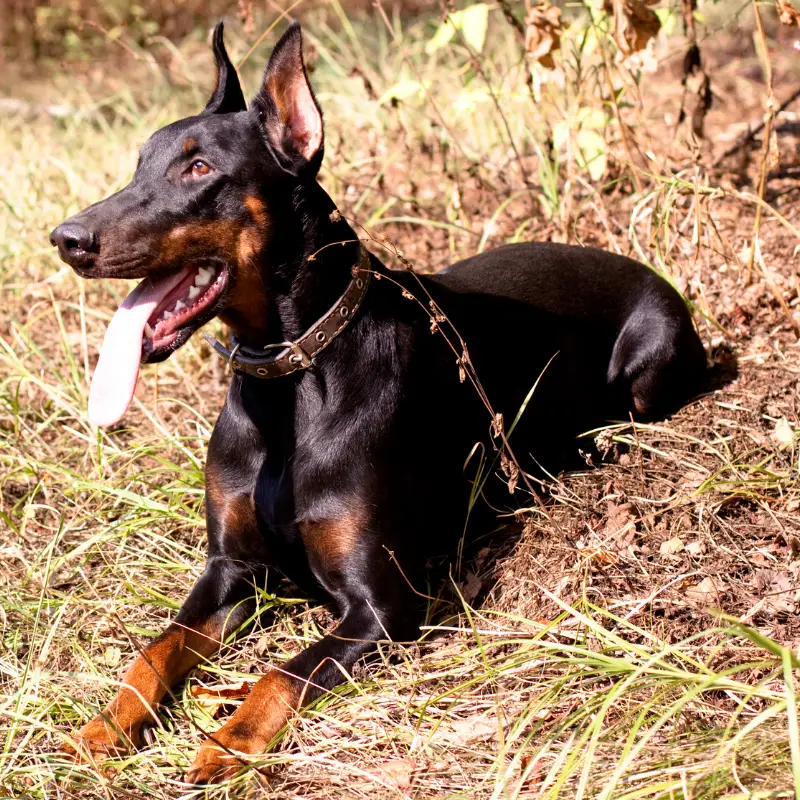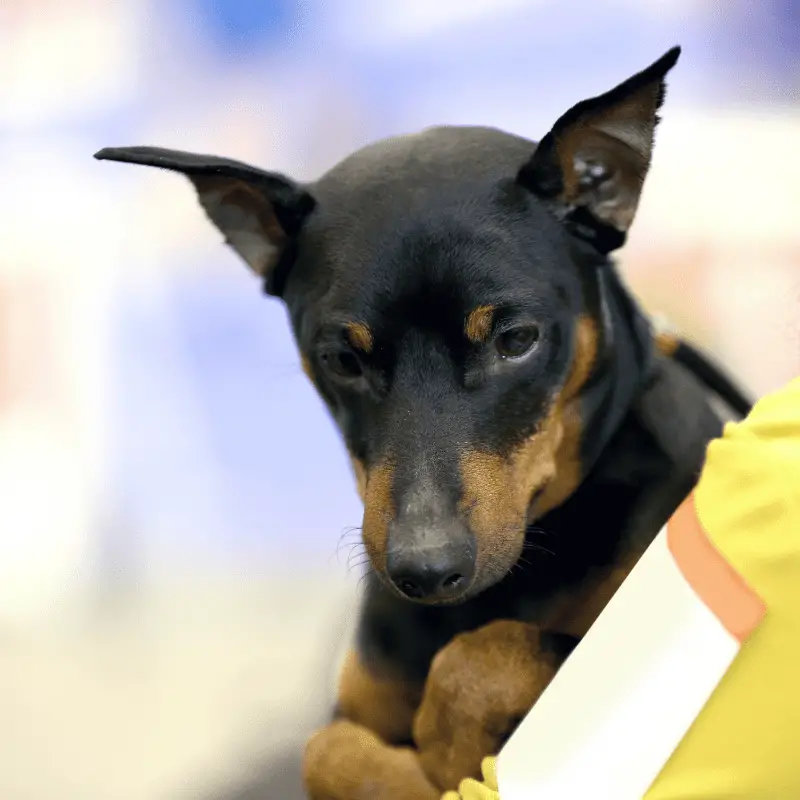The Dobermann, also known as the Doberman Pinscher which is a slightly changed version, is a domestic dog. The medium-build dog was first created around the 1870s in Germany. Karl Friedrich Louis Dobermann, a tax collector, first bred this dog. These dogs come with a long muzzle, stand on the pads of their feet and are usually very light-footed.
Ideally, the Dobermann dogs should have a graceful gait. The ears of the dogs are generally cropped, and the tail is also docked. However, as these procedures have become illegal in some countries, you can now see Dobermann with small tails and hanging ears.
The Dobermann dog breed is known for its loyalty. The history of the Dobermann indicates that these dogs are intelligent, alert and tenacious. All these qualities, as well as its fierce loyalty, make the Dobermann an excellent guard dog.
While the dog’s personality can vary significantly from one canine to the next, proper training can sort this issue out quite effectively. Once the dogs are properly trained, they become devoted and loving pets who like to guard you ferociously. Most of the Dobermann’s are driven, stubborn and strong-willed. As they are very intelligent, they tend to learn any tactics reasonably quickly. That’s why training Dobermann dogs is not that difficult.
History
Since the invention of the money and taxation system, it has been a well-established fact that the tax collectors are never welcome guests into our homes.
During the 19th century, the precincts of Germany were downright hostile to the people who came to collect their taxes. Being a tax collector himself, the german breeder Louis Dobermann was sorely aware of the fact. The History of the Dobermann indicates that to make his work easier, he tried to breed a dependable but majestic breed of dogs that could protect him on his round to the homes for tax collection.
Even though the history of the Dobermann breed is not that long, it is undoubtedly full of a lot of exciting stories. That being said, let’s look at the breed’s historical progression to understand it better.
The 1870s-1880s
Dobermann was first bred by Karl Freidrich Louis Dobermann, a resident of Apolda, Thuringia, Germany. By profession, Louis Dobermann was a tax collector. Along with that, he also ran the Apolda dog pound.
Being the owner of the dog pound, he had access to the dogs of different breeds. This and the hostile behaviour of the people towards the tax collectors gave him the idea of creating a breed of dog that would protect him while he collects the tax.
The first Dobermann was shown to the public in 1876. From the first look, the breed won the hearts of people.
1894
With the death of Louis Dobermann, the popularity of the breed plummeted significantly. During this time, these dogs were named Dobermann Pinscher in his honour.
1895
During this time, the Dobermann was crossbred with the Manchester Terriers to improve the look and feel of the breed. During this time, Otto Goeller, one of the first breeders of the Dobermann, started the National Dobermann Pinscher Club. He was one of the major promoters of the breed after the death of Louis. In fact, he established the rules and regulations of the breeding of Dobermann. Along with Oskar Vorwerk and other breeders, he set the breeding standards as well.
By the 1900s, the breeding standards of the Dobermann dogs were created and accepted by the German Kennel Club. Many other Dobermann breeding clubs were established across Germany including towns, like Berlin, Hanover, Mannheim, Frankfurt, and Hamburg.
Early 20th century
At the beginning of this century, the greyhound bloodline was introduced with the Dobermans. It is a known fact that many different breed bloodlines have been introduced to the Doberman breed to bring the best out in the dog. The physical features of the early Dobermann were different from the Dobermann of today. It is surmised that the influence of the other dog breeds, like German Pinscher, Beauceron, Weimaraner and the Rottweiler, have been introduced to create the Dobermann of today.
However, the exact ratio or mixing and even the actual name of the breeds remained uncertain to date as there was no documentation of the breedings. The only happy exception is the introduction of the Manchester Terrier and Greyhound to the mix. The introduction of these two breeds to the Dobermann was well documented. The breeders also believe that the German Shepherd dogs are among the largest contributors to the Dobermann breed. But there is hardly any documentation regarding this. The experts of the American Kennel Club think that the breeders used the short-haired Shepherd, Black and Tan Terrier, German Pinscher and the Rottweilers to create the breed.
So, the popularity of the Dobermann Pinscher started to spread across the world. The dogs were starting to get exported to other countries around the world. Like loyalty and protectiveness, the highly desirable qualities made the Dobermann one of the favourite house pets of people, and there was no turning back to it.

1908
This year, the American Kennel Club recognised the breed for the first time. Since then, the breed has been a popular choice of pet lovers for its intelligence, agility and loyalty.
1921
In this year, the Dobermann Pinscher Club of America was created.
1936
The impact of the First World War affected Dobermann dogs drastically during this time. The number of Dobermanns in Europe dwindled significantly as more and more people could not feed large family dogs due to financial instability. Police, military and rich people adopted most of the Dobermanns that survived during these periods.
1939
The Dobermann dogs won the Westminster Kennel Club dog show, which helped the breed’s popularity to soar.
1939-1945
During World War II, the Dobermanns worked along with the army and marine corps of the United States. The United States Marine Corps, in fact, adopted the Doberman as their official war dog. They, however, did not solely use the Dobermanns during the war.
One of the best war stories of the Dobermann is associated with the battle of Guam. During the battle of Guam in 1944, the Doberman Pinchers served along with the US Marine Corps. The American Doberman Pinscher Club also helped in recruiting these dogs with the military. As these dogs fought fearlessly in the battle, they were nicknamed the devil Dogs.
During the battle, 25 of the working Dobermann gave their lives while saving hundreds of service members in the process. These dogs were trained to perform specific roles as sentry dogs, messenger dogs and scout dogs. Throughout the conflict, these Dobermanns completed about 550 patrols. Right now, there is a statue in Guam that honours the sacrifice of the 25 Dobermann who gave their lives in the war. The name of the statue is Always Faithful.
1948
Even though the Germans named the breed Dobermann Pinscher in honour of the late Louis Dobermann, during this time, they dropped the term Pinscher from the name. The history of the Dobermann indicated that the breeders argued that the dog is not a representative of the Pinscher breed. So, the name of the breed should not carry the term. Most of the countries accepted the change of name and have been calling the breed Dobermann ever since. The only exception is the USA and Canada. To date, these two countries recognise the breed as Dobermann Pinscher.
1952, 1953
After the war, the Dobermann dogs again won the Westminster Kennel Club Dog Shows.
The 1970s
The fact that the Dobermann dogs worked as the guard dogs during World War II and sacrificed their lives made people love the dog even more. That is one reason why, during the 1970s, Dobermann started appearing in different American movies. One of such famous films was named The Doberman Gang.
1989
While the dogs were still popular, they again participated in the Westminster Kennel Club Dog Show and won. This win has helped the breed to retain its popularity even today.

1999
In the memory of the humble tax collector and the breeder of the Dobermann dogs, Louis Dobermann, a bronze statue was erected in his home town Apolda. The statue depicted a family of Dobermann and was created by the sculptor Kerstein Stockel.
2001
When the world trade centre collapsed, the Dobermanns were deployed for finding the survivors and the bodies at ground zero.
2012 and 2013
The American Kennel Club declared the Dobermann Pinscher the 12th most popular dog breed in 2012 and 2013.
All in all, the Dobermans have seen a significant change over time. From the aggressive and protective dogs, selective breeding has turned the Dobermanns into loving companions. Even though the Dobermanns of today are still exceptionally protective of their owners, the breeders are slowly moving away from the aggressive quality.
Conclusion
That being said, Dobermanns are an exceptionally intelligent breed. The History of the Dobermann shows that with proper training and socialising, they can become one of the most trusted partners that you can have. Starting from police dogs to protection dogs, these agile and intelligent Dobermanns can serve many purposes. As these dogs tend to bond with kids and enjoy being a part of their lives, the Dobermanns make the best family dogs.













